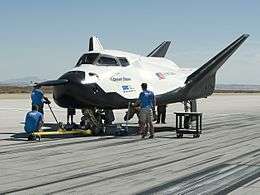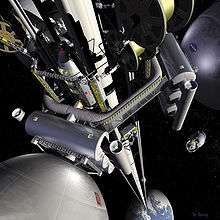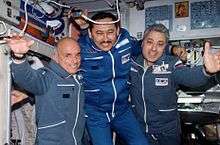Spaceplane
A spaceplane is an aerospace vehicle that can fly/glide like an aircraft in Earth's atmosphere and maneuver like a spacecraft in the vacuum of space.[1] To do so, spaceplanes must incorporate features of both aircraft and spacecraft, occupying an intermediate space between the two. Orbital spaceplanes are more like spacecraft, while sub-orbital spaceplanes are more like fixed-wing aircraft. All spaceplanes to date have been rocket-powered but then landed as unpowered gliders.
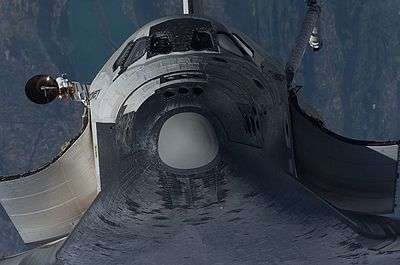
Three types of spaceplane have successfully launched to orbit, reentered Earth's atmosphere, and landed: the Space Shuttle, Buran, and the X-37. Another, Dream Chaser, is under development. As of 2019 all past, current, and planned orbital vehicles launch vertically on a separate rocket. Orbital spaceflight takes place at high velocities, with orbital kinetic energies typically at least 50 times greater than suborbital trajectories. Consequently, heavy heat shielding is required during reentry as this kinetic energy is shed in the form of heat. Many more spaceplanes have been proposed, but none have reached flight status.
At least three suborbital rocket-powered aircraft have been launched horizontally into sub-orbital spaceflight from an airborne carrier aircraft before rocketing beyond the Kármán line: the X-15, SpaceShipOne, and SpaceShipTwo.
Challenges
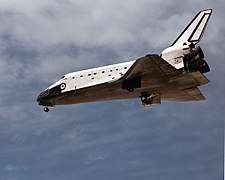
Spaceplanes must operate in space, like traditional spacecraft, but also must be capable of atmospheric flight, like an aircraft. These requirements drive up the complexity, risk, dry mass, and cost of spaceplane designs. The following sections will draw heavily on the US Space Shuttle as the biggest, deadliest, most complex, most expensive, most flown, and only crewed orbital spaceplane, but other designs have been successfully flown.
Launch to space
The flight trajectory required to reach orbit results in significant aerodynamic loads, vibrations, and accelerations, all of which have to be withstood by the vehicle structure.
If the launch vehicle suffers a catastrophic malfunction, a conventional capsule spacecraft is propelled to safety by a launch escape system. The Space Shuttle was far too big and heavy for this approach to be viable, resulting in a number of abort modes that may or may not have been survivable. In any case, the Challenger disaster demonstrated that the Space Shuttle lacked survivability on ascent.
Space environment
Once on-orbit, a spaceplane must be supplied with power by solar panels and batteries or fuel cells, maneuvered in space, kept in thermal equilibrium, oriented, and communicated with. On-orbit thermal and radiological environments impose additional stresses. This is in addition to accomplishing the task the spaceplane was launched to complete, such as satellite deployment or science experiments.
The Space Shuttle used dedicated engines to accomplish orbital maneuvers. These engines used toxic hypergolic propellants that required special handling precautions. Various gases, including helium for pressurization and nitrogen for life support, were stored under high pressure in composite overwrapped pressure vessels.
Atmospheric reentry
Orbital spacecraft reentering the Earth's atmosphere must shed significant velocity, resulting in extreme heating. For example, the Space Shuttle thermal protection system (TPS) protects the orbiter's interior structure from surface temperatures that reach as high as 1,650 °C (3,000 °F), well above the melting point of steel.[2] Suborbital spaceplanes fly lower energy trajectories that do not put as much stress on the spacecraft thermal protection system.
The Space Shuttle Columbia disaster was the direct result of a TPS failure.
Aerodynamic flight and horizontal landing
Aerodynamic control surfaces must be actuated. Landing gear must be included at the cost of additional mass.
Air-breathing orbital spaceplane concept
An air-breathing orbital spaceplane would have to fly what is known as a 'depressed trajectory,' which places the vehicle in the high-altitude hypersonic flight regime of the atmosphere for an extended period of time. This environment induces high dynamic pressure, high temperature, and high heat flow loads particularly upon the leading edge surfaces of the spaceplane, requiring exterior surfaces to be constructed from advanced materials and/or use active cooling.
Orbital spaceplanes
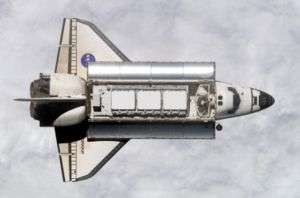
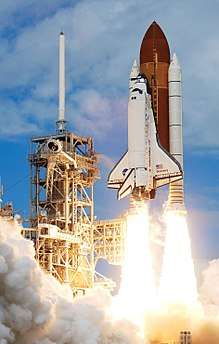
Space Shuttle
The Space Shuttle was a crewed partially reusable low Earth orbital spacecraft system operated by NASA as part of the Space Shuttle program. Its official program name was Space Transportation System (STS), taken from a 1969 plan for a system of reusable spacecraft of which it was the only item funded for development.[3] The first of four crewed orbital test flights occurred in 1981, leading to operational flights beginning in 1982. In addition to the prototype whose completion was cancelled, five complete Shuttle systems were built and used on a total of 135 missions from 1981 to 2011, launched from the Kennedy Space Center (KSC) in Florida. The Shuttle fleet's total mission time was 1322 days, 19 hours, 21 minutes and 23 seconds.[4]
Shuttle components included the Orbiter Vehicle (OV) with three clustered Rocketdyne RS-25 main engines, a pair of recoverable solid rocket boosters (SRBs), and the expendable external tank (ET) containing liquid hydrogen and liquid oxygen. The Space Shuttle was launched vertically, like a conventional rocket, with the two SRBs operating in parallel with the OV's three main engines, which were fueled from the ET. The SRBs were jettisoned before the vehicle reached orbit, and the ET was jettisoned just before orbit insertion, which used the orbiter's two Orbital Maneuvering System (OMS) engines. At the conclusion of the mission, the orbiter fired its OMS to de-orbit and re-enter the atmosphere. The orbiter then glided to a runway landing, usually to the Shuttle Landing Facility at Kennedy Space Center, Florida or Rogers Dry Lake in Edwards Air Force Base, California. After landing at Edwards, the orbiter was flown back to the KSC on the Shuttle Carrier Aircraft, a specially modified Boeing 747.
Buran
Buran was a Soviet reusable spacecraft project that began in 1974 at the Central Aerohydrodynamic Institute in Moscow and was formally suspended in 1993. In addition to being the designation for the whole Soviet/Russian reusable spacecraft project, Buran was also the name given to Orbiter K1, which completed one uncrewed spaceflight in 1988 and was the only Soviet reusable spacecraft to be launched into space. The Buran-class orbiters used the expendable Energia rocket as a launch vehicle. They are generally treated as a Soviet equivalent of the United States' Space Shuttle, but in the Buran project, only the airplane-shaped orbiter itself was theoretically reusable. While Orbiter K1 was recovered successfully after its first orbital flight in 1988, it was never reused.
The Buran program was started by the Soviet Union as a response to the United States Space Shuttle program.[5] The project was the largest and the most expensive in the history of Soviet space exploration.[6] Development work included sending BOR-5 test vehicles on multiple sub-orbital test flights, and atmospheric flights of the OK-GLI aerodynamic prototype. Buran completed one uncrewed orbital spaceflight in 1988 before its cancellation in 1993.[6] Orbiter K1, which flew the test flight in 1988 was crushed in a hangar collapse on 12 May 2002 in Kazakhstan. The OK-GLI resides in Technikmuseum Speyer. Although Buran was similar in appearance to NASA's Space Shuttle orbiter and similarly re-entered as a spaceplane, its internal and functional design was distinct. For example, the main engines during launch were on the Energia rocket and were not taken into orbit by the spacecraft. Smaller rocket engines on the craft's body provided propulsion in orbit and de-orbital burns.
X-37
The Boeing X-37, also known as the Orbital Test Vehicle (OTV), is a reusable robotic spacecraft. It is boosted into space by a launch vehicle, then re-enters Earth's atmosphere and lands as a spaceplane. The X-37 is operated by the United States Air Force for orbital spaceflight missions intended to demonstrate reusable space technologies.[7] It is a 120%-scaled derivative of the earlier Boeing X-40.
The X-37 began as a NASA project in 1999, before being transferred to the U.S. Department of Defense in 2004. It is capable of long duration flights for classified purposes, likely including materials testing. The X-37 launches atop an Atlas V 501.[8]
Dream Chaser
Dream Chaser is under development for NASA's Commercial Resupply Services program.
In December 2010, Sierra Nevada Corporation made a commercial proposal to NASA to develop the lifting-body Dream Chaser in response to NASA's Commercial Crew Development (CCDev) solicitation. The vehicle would be launched on a human-rated Atlas V rocket but would land on a runway.[9]
Suborbital rocket planes
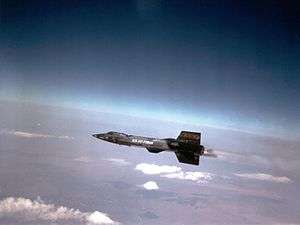
Three piloted suborbital rocket powered aircraft have reached space: the North American X-15, SpaceShipOne, and SpaceShipTwo. All these crafts were not capable of entering orbit and were first lifted to high altitude by a carrier aircraft.
On 7 December 2009, Scaled Composites and Virgin Galactic unveiled SpaceShipTwo, along with its atmospheric mothership "Eve". On 13 December 2018 SpaceShipTwo VSS Unity successfully crossed the boundary of space.[10]
The Mikoyan-Gurevich MiG-105 was an atmospheric prototype of an intended orbital spaceplane, with the suborbital BOR-4 subscale heat shield test vehicle successfully reentering the atmosphere before program cancellation.
HYFLEX was a miniaturized suborbital demonstrator launched in 1996, flying to 110 km altitude, achieving hypersonic flight, and successfully reentering the atmosphere.[11][12]
History of unflown concepts
Various types of spaceplanes have been suggested since the early twentieth century. Notable early designs include a spaceplane equipped with wings made of combustible alloys that it would burn during its ascent, and the Silbervogel bomber concept. World War II Germany and the postwar US considered winged versions of the V-2 rocket, and in the 1950s and '60s winged rocket designs inspired science fiction artists, filmmakers, and the general public.
United States (1950s–2010s)
The U.S. Air Force invested some effort in a paper study of a variety of spaceplane projects under their Aerospaceplane efforts of the late 1950s, but later reduced the scope of the project. The result, the Boeing X-20 Dyna-Soar, was to have been the first orbital spaceplane, but was canceled in the early 1960s in lieu of NASA's Project Gemini and the U.S. Air Force's crewed spaceflight program.
In 1961, NASA originally planned to have the Gemini spacecraft land on a runway[13] with a Rogallo wing airfoil, rather than an ocean landing under parachutes. The test vehicle became known as the Paraglider Research Vehicle. Development work on both parachutes and the paraglider began in 1963.[14] By December 1963, the parachute was ready to undergo full-scale deployment testing, while the paraglider had run into technical difficulties.[14] Though attempts to revive the paraglider concept persisted within NASA and North American Aviation, in 1964 development was definitively discontinued due to the expense of overcoming the technical hurdles.[15]
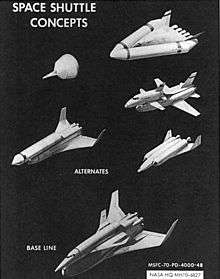
The Space Shuttle underwent many variations during its conceptual design phase. Some early concepts are illustrated.
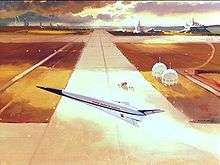
The Rockwell X-30 National Aero-Space Plane (NASP), begun in the 1980s, was an attempt to build a scramjet vehicle capable of operating like an aircraft and achieving orbit like the shuttle. Introduced to the public in 1986, the concept was intended to reach Mach 25, enabling flights between Dulles Airport to Tokyo in two hours, while also being capable of low Earth orbit.[16] Six critical technologies were identified, three relating to the propulsion system, which would consist of a hydrogen-fueled scramjet.[16]
The NASP program became the Hypersonic Systems Technology Program (HySTP) in late 1994. HySTP was designed to transfer the accomplishments made in hypersonic flight into a technology development program. On 27 January 1995 the Air Force terminated participation in (HySTP).[16]
In 1994, a USAF captain proposed an F-16 sized single stage to orbit peroxide/kerosene spaceplane called "Black Horse".[17] It was to take off almost empty and undergo aerial refueling before rocketing to orbit.[18]
The Lockheed Martin X-33 was a 1/3 scale prototype made as part of an attempt by NASA to build a SSTO hydrogen-fuelled spaceplane VentureStar that failed when the hydrogen tank design could not be constructed as intended.
On 5 March 2006, Aviation Week & Space Technology published a story purporting to be the "outing" of a highly classified U.S. military two-stage-to-orbit spaceplane system with the code name Blackstar.[19]
In 2011, Boeing proposed the X-37C, a 165 to 180 percent scale X-37B built to carry up to six passengers to low-Earth orbit. The spaceplane was also intended to carry cargo, with both upmass and downmass capacity.[20]
Soviet Union (1960s–1991)
The Soviet Union first considered a preliminary design of rocket-launch small spaceplane Lapotok in early 1960s. The Spiral airspace system with small orbital spaceplane and rocket as second stage was developed in the 1960s–1980s. Mikoyan-Gurevich MiG-105 was a crewed test vehicle to explore low-speed handling and landing.[21]
Russia
In the early 2000s the orbital 'cosmoplane' (Russian: космоплан) was proposed by Russia's Institute of Applied Mechanics as a passenger transport. According to researchers, it could take about 20 minutes to fly from Moscow to Paris, using hydrogen and oxygen-fueled engines.[22][23]
United Kingdom
The Multi-Unit Space Transport And Recovery Device (MUSTARD) was a concept explored by the British Aircraft Corporation (BAC) around 1968 for launching payloads weighing as much as 2,300 kg (5,000 lb) into orbit. It was never constructed.[24] The British Government also began development of a SSTO-spaceplane, called HOTOL, but the project was canceled due to technical and financial issues.[25]
The lead engineer from the HOTOL project has since set up a private company dedicated to creating a similar plane called Skylon.[26]
The British company Bristol Spaceplanes has undertaken design and prototyping of three potential spaceplanes since its founding by David Ashford in 1991. The European Space Agency has endorsed these designs on several occasions.[27]
European Space Agency (1985–)
France worked on the Hermes crewed spaceplane launched by Ariane rocket in the late 20th century, and proposed in January 1985 to go through with Hermes development under the auspices of the ESA.[28]
In the 1980s, West Germany funded design work on the MBB Sänger II with the Hypersonic Technology Program. Development continued on MBB/Deutsche Aerospace Sänger II/HORUS until the late 1980s when it was canceled. Germany went on to participate in the Ariane rocket, Columbus space station and Hermes spaceplane of ESA, Spacelab of ESA-NASA and Deutschland missions (non-U.S. funded Space Shuttle flights with Spacelab). The Sänger II had predicted cost savings of up to 30 percent over expendable rockets.[29][30]
Hopper was one of several proposals for a European reusable launch vehicle (RLV) planned to cheaply ferry satellites into orbit by 2015.[31] One of those was 'Phoenix', a German project which is a one-seventh scale model of the Hopper concept vehicle.[32] The suborbital Hopper was a Future European Space Transportation Investigations Programme system study design[33] A test project, the Intermediate eXperimental Vehicle (IXV), has demonstrated lifting reentry technologies and will be extended under the PRIDE programme.[34]
Japan
HOPE was a Japanese experimental spaceplane project designed by a partnership between NASDA and NAL (both now part of JAXA), started in the 1980s. It was positioned for most of its lifetime as one of the main Japanese contributions to the International Space Station, the other being the Japanese Experiment Module. The project was eventually cancelled in 2003, by which point test flights of a sub-scale testbed had flown successfully.
India
AVATAR (Aerobic Vehicle for Hypersonic Aerospace Transportation; Sanskrit: अवतार) was a concept study for an uncrewed single-stage reusable spaceplane capable of horizontal takeoff and landing, presented to India's Defence Research and Development Organisation. The mission concept was for low cost military and commercial satellite launches.[35][36][37] No further studies or development have taken place since 2001.
Current development programs
Skylon
A private, United Kingdom-based project initiated by the lead HOTOL engineer, Skylon is a single stage to orbit vehicle with a precooled jet engine called SABRE. This vehicle is intended to be capable of carrying a 15,000 kg (33,000 lb) payload into low Earth orbit.[26]
European Union
A test project, the Intermediate eXperimental Vehicle (IXV), has demonstrated lifting reentry technologies and will be extended under the PRIDE programme.[38] The FAST20XX Future High-Altitude High Speed Transport 20XX aims to establish sound technological foundations for the introduction of advanced concepts in suborbital high-speed transportation with air-launch-to-orbit ALPHA vehicle.[39]
The Daimler-Chrysler Aerospace RLV is a small reusable spaceplane prototype for the ESA Future Launchers Preparatory Programme/FLTP program. SpaceLiner is the most recent project.
Winged Reusable Sounding Rocket
As of 2018, Japan is developing the Winged Reusable Sounding rocket (WIRES), which if successful, may be used as a recoverable first-stage or as a crewed sub-orbital spaceplane.[40]
India
As of 2016, the Indian Space Research Organisation is developing a launch system named the Reusable Launch Vehicle (RLV). It is India's first step towards realizing a two-stage-to-orbit reusable launch system. A space plane serves as the second stage. The plane is expected to have air-breathing scramjet engines as well as rocket engines. Tests with miniature spaceplanes and a working scramjet have been conducted by ISRO in 2016.[41]
Shenlong
Shenlong (Chinese: 神龙; pinyin: shén lóng; lit.: 'divine dragon') is a proposed Chinese robotic spaceplane that is similar to the Boeing X-37.[42] Only a few images have been released since late 2007.[43][44][45]
See also
- Ansari X Prize
- Dream Chaser
- List of crewed spacecraft
- List of space launch system designs
- List of spaceplanes
- Spaceflight
References
- Chang, Kenneth (20 October 2014). "25 Years Ago, NASA Envisioned Its Own 'Orient Express'". The New York Times. Retrieved 21 October 2014.
- "Orbiter Thermal Protection System". NASA/Kennedy Space Center. 1989. Archived from the original on 9 September 2006.
- Launius, Roger D. "Space Task Group Report, 1969". NASA.
- Malik, Tarik (21 July 2011). "NASA's Space Shuttle By the Numbers: 30 Years of a Spaceflight Icon". Space.com.
- Russian shuttle dream dashed by Soviet crash. YouTube.com. Russia Today. 15 November 2007. Retrieved 16 July 2009.
- Harvey, Brian (2007). The Rebirth of the Russian Space Program: 50 Years After Sputnik, New Frontiers. Springer. p. 8. ISBN 978-0387713564.
- "Fact Sheet: X-37 Orbital Test Vehicle". U.S. Air Force. 21 May 2010. Archived from the original on 26 June 2014.
- David, Leonard (7 October 2011). "Secretive US X-37B Space Plane Could Evolve to Carry Astronauts". Space.com. Retrieved 5 August 2015.
- "Companies submit plans for new NASA spacecraft". Daily Record. 17 December 2010. Retrieved 20 December 2010.
- Grush, Lauren (13 December 2018). "Virgin Galactic's spaceplane finally makes it to space for the first time". theverge.com. Retrieved 13 December 2018.
- "Hyflex". Astronautix.com. Archived from the original on 19 January 2011. Retrieved 15 May 2011.
- "HYFLEX". Space Transportation System Research and Development Center, JAXA. Archived from the original on 25 November 2011. Retrieved 15 May 2011.
- Hacker & Grimwood 1977, pp. xvi–xvii.
- Hacker & Grimwood 1977, pp. 145–148.
- Hacker & Grimwood 1977, pp. 171–173.
- "X-30 National Aerospace Plane (NASP)". Federation of American Scientists. Archived from the original on 21 April 2010. Retrieved 30 April 2010.
- "Black Horse". Astronautix.com. Archived from the original on 22 July 2008.
- Zubrin, Robert M.; Clapp, Mitchell Burnside (June 1995). "Black Horse: One Stop to Orbit". Analog Science Fiction and Fact. Vol. 115 no. 7.
- "Two-Stage-to-Orbit 'Blackstar' System Shelved at Groom Lake?." Scott, W., Aviation Week & Space Technology. March 5, 2006.
- Leonard, David (7 October 2011). "Secretive US X-37B Space Plane Could Evolve to Carry Astronauts". Space.com. Retrieved 13 October 2011.
- Gordon, Yefim; Gunston, Bill (2000). Soviet X-planes. Leicester: Midland Publishers. ISBN 1-85780-099-0.
- "Russia Develops New Aircraft – Cosmoplane". Russia-InfoCentre. 27 February 2006. Retrieved 13 June 2015.
- "Космоплан – самолет будущего". RusUsa.com. 3 November 2003.
- Darling, David (2010). "MUSTARD (Multi-Unit Space Transport and Recovery Device)". Retrieved 29 September 2010.
- "HOTOL History". Reaction Engines Limited. 2010. Archived from the original on 8 August 2010. Retrieved 29 September 2010.
- "Skylon FAQ". Reaction Engines Limited. 2010. Archived from the original on 2 June 2015. Retrieved 29 September 2010.
- "Bristol Spaceplanes Company Information". Bristol Spaceplanes. 2014. Retrieved 26 September 2014.
- Bayer, Martin (August 1995). "Hermes: Learning from our mistakes". Space Policy. 11 (3): 171–180. Bibcode:1995SpPol..11..171B. doi:10.1016/0265-9646(95)00016-6.
- "Saenger II". Astronautix.com. Retrieved 26 September 2014.
- "Germany and Piloted Space Missions". Space Policy Project. Federation of American Scientists. Archived from the original on 2 April 2015. Retrieved 26 September 2014.
- McKee, Maggie (10 May 2004). "Europe's space shuttle passes early test". New Scientist.
- "Launching the next generation of rockets". BBC News. 1 October 2004.
- Dujarric, C. (March 1999). "Possible Future European Launchers, A Process of Convergence" (PDF). ESA Bulletin. European Space Agency (97): 11–19.
- Hsu, Jeremy (15 October 2008). "Europe Aims For Re-entry Spacecraft". Space.com.
- "Indian Scientists unveils space plane Avatar in US". Gujarat Science City. 10 July 2001. Archived from the original on 22 December 2015. Retrieved 22 October 2014.
- "India Eyes New Spaceplane Concept". Space Daily. 8 August 2001. Retrieved 22 October 2014.
- "AVATAR- Hyper Plane to be built by INDIA". India's Military and Civilian Technological Advancements. 19 December 2011.
- Hsu, Jeremy (15 October 2008). "Europe Aims For Re-entry Spacecraft". Space.com.
- "FAST20XX (Future High-Altitude High-Speed Transport 20XX) / Space Engineering & Technology / Our Activities / ESA". Esa.int. 2 October 2012.
- Koichi, Yonemoto; Takahiro, Fujikawa; Toshiki, Morito; Joseph, Wang; Ahsan r, Choudhuri (2018), "Subscale Winged Rocket Development and Application to Future Reusable Space Transportation", Incas Bulletin, 10: 161–172, doi:10.13111/2066-8201.2018.10.1.15
- "India's Reusable Launch Vehicle-Technology Demonstrator (RLV-TD), Successfully Flight Tested". Indian Space Research Organisation. 23 May 2016. Retrieved 27 December 2016.
- David, Leonard (9 November 2012). "China's Mystery Space Plane Project Stirs Up Questions". Space.com. Retrieved 13 June 2015.
- Fisher, Jr, Richard (3 January 2008). "...And Races into Space". International Assessment and Strategy Center.
- Fisher, Jr, Richard (17 December 2007). "Shenlong Space Plane Advances China's Military Space Potential". International Assessment and Strategy Center.
- Foust, Jeff (3 January 2008). "Invoking China to keep the shuttle alive". Space Politics.
Bibliography
- Hacker, Barton C.; Grimwood, James M. (1977). On the Shoulders of Titans: A History of Project Gemini. Washington, D.C.: NASA. OCLC 3821896. NASA SP-4203.
- Kuczera, Heribert; Sacher, Peter W. (2011). Reusable Space Transportation Systems. Berlin: Springer. ISBN 978-3-540-89180-2.
External links
| Wikimedia Commons has media related to Spaceplanes. |
- Sierra Nevada Corporation, Dream Chaser® - America's Spaceplane™
.jpg)
